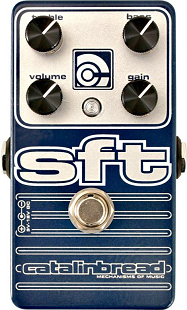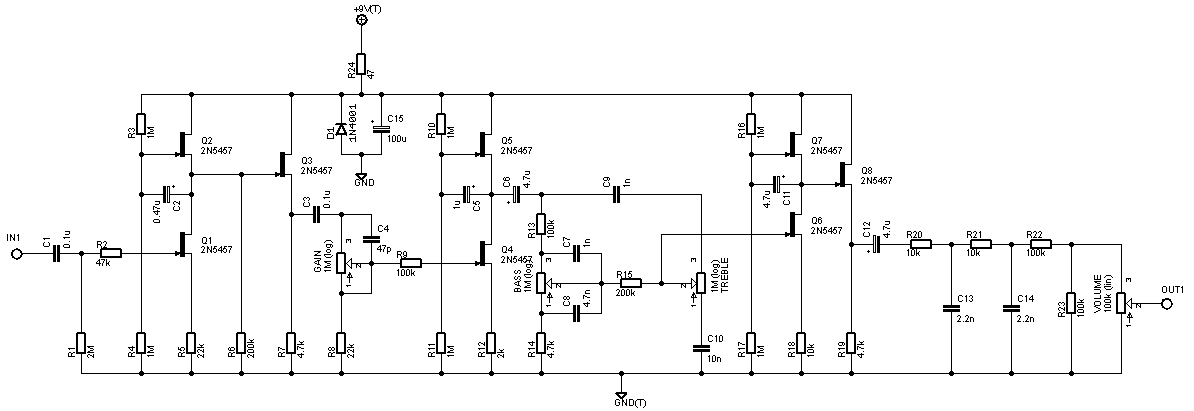SFT
Catalinbread developed the SFT as a bass overdrive pedal to serve as an emulator for the famous Ampeg SVT line of amps. Just as many guitar players took a liking to the Fender Bassman amp (which was also designed for electric bass), and just as the Bassman served as the basis for the Marshall JTM, many guitar players have also taken a liking to Ampeg amps and used them for guitar as well.
- Thermionic Studios has one(1) Catalinbread SFT pedal available for rental.
Controls

- Knob 1 - "Treble": Turn the knob increasingly clockwise to increase the treble frequencies.
- Knob 2 - "Bass": Turning the knob clockwise increases the bass frequencies.
- Knob 3 - "Volume": Turning the knob clockwise increases the volume output on the pedal.
- Knob 4 - "Gain": Turning the knob clockwise increases the amount of distortion available and output by the pedal.
- Footswitch 1 - "On/Off": This toggles the pedal between being engaged (on), and bypassed (off).
Not unlike the Catalinbread Manx Loaghtan fuzz, the SFT implements a Baxandall tone stack.
- NOTE
- Newer versions of the SFT have a push-button switch to toggle between "Stones" (up/disengaged) and "Stoner" (pressed down/engaged). Our version is older and does not have this button. According to the latest Catalinbread SFT Owner's Manual, that push button is a gain boost, pushing the button down increases the gain. Our experience is that the gain knob on our earlier model has a wider sweep, enabling all the gain that is available on the latest pedal. We suspect Catalinbread retooled the SFT with an additional resistor at the gain stage, designed to limit the amount of signal, and that resistance is removed when the button is depressed - allowing more signal to hit the gain stage, resulting in "more gain"...
Bypass: True
The Catalinbread SFT is True Bypass.
General Information
As has been previously mentioned, this pedal was designed primarily for bass, but indiscriminate use of "wrong" music equipment by musicians is marked by promiscuity (in other words, it happens often). Certain bass players have no qualms using keyboard amps, and guitarists using bass amps - especially if the result sounds good. And so on and so on it goes. Sometimes all that matters is that a broke musician can cobble together to make something that sounds good. So that's what they do.
So that having been said, while the SFT was developed primarily as a bass overdrive, when the gain is turned up, and a guitar is plugged in, it not only can do good stoner "volume worship" tones, but it can also get pretty good sounding high-gain distortion as well, which ends up being a surprise to many.
Pedal Manual
http://www.catalinbread.com/manuals/SFTmanual.pdf
Phase Inversion: Yes
So we've figured this out!
It was difficult because sometimes it's hard to keep the AC power flows mentally separate from the DC power flows.
Here's the explanation: Yes, the drain leg of the Q1 transistor is indeed feeding the gate of Q3 (with AC!), but the source leg of the Q2 transistor is simultaneously feeding the drain of Q1 (with DC power). What this means is that Q2 is being used to power the drain of Q1 for the (AC)signal to come through the gate on Q1 and then be amplified (and inverted) on the drain of Q1. The signal then goes to Q3, but instead of the signal going out the drain (and being amplified/inverted), it flows out of the source leg - not unlike a buffer stage.
The same happens for transistors Q5 and Q7: they're operating similarly to Q2, excepting that Q2 has a relatively fixed amount of signal flowing through it due to the resistors and ground at Q2's gate. Q5 and Q7 similarly appear to be employed in throttling the amount of (DC) power going into Q4 and Q6 (respectively) and therefore the level of amplification that Q4 and Q6 are capable of. It's almost as if Q5, and Q7 are acting as noise gates:
- When there's audio signal going through the circuit, there's more (DC) power being made available to the amplifying transistors (Q4, and Q6) thereby increasing the possible amount of amplification.
- When there's no signal, the amount of DC power available to Q4 and Q6 falls, thereby limiting amplification.
| Schematic ID | Electronic Part | Action | Phase State |
|---|---|---|---|
| Q1 | 2N5457 | Inverts | Inverted |
| Q2 | 2N5457 | NA* | NA* |
| Q3 | 2N5457 | Does Not Invert | Inverted |
| Q4 | 2N5457 | Inverts | Not Inverted |
| Q5 | 2N5457 | NA* | NA* |
| Q6 | 2N5457 | Inverts | Inverted |
| Q7 | 2N5457 | NA* | NA* |
| Q8 | 2N5457 | Does Not Invert | Inverted |
Transistors Q2, Q5, and Q7 are marked "NA*" as they're not amplifying or altering signal.
Schematic
Schematic obtained from this discussion board thread: http://musikding.rocks/wbb/index.php/Thread/16285-Catalinbread-SFT/?pageNo=12
The entry on the linked thread claims that the original schematic was downloaded from: http://juansolo.demon.co.uk/stompage/schematics/Catalinbread/SFT_Schematic.png which is no longer available as a site. Even "demon.co.uk" is apparently gone. We finally found the correct "Juansolo" with goofy-fied Star Wars nickname - on the Madbean Pedals forum. After having talked with him we know he was affiliated with Rej from GrindCustomsFX.com, but he ended up telling us that Rej has, for all practical purposes, abandoned GrindCustomsFX.com...
Artists
We are currently unaware of any artists actively using the pedal now, or who have in the past.
- Additional Sources
